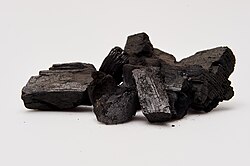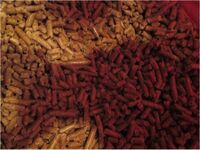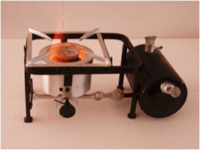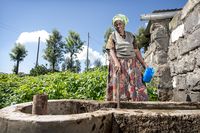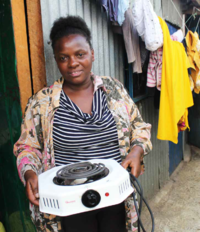Knowledge fuels change - Support energypedia!
For over 10 years, energypedia has been connecting energy experts around the world — helping them share knowledge, learn from each other, and accelerate the global energy transition.
Today, we ask for your support to keep this platform free and accessible to all.
Even a small contribution makes a big difference! If just 10–20% of our 60,000+ monthly visitors donated the equivalent of a cup of coffee — €5 — Energypedia would be fully funded for a whole year.
Is the knowledge you’ve gained through Energypedia this year worth €5 or more?
Your donation keeps the platform running, helps us create new knowledge products, and contributes directly to achieving SDG 7.
Thank you for your support, your donation, big or small, truly matters!
Cooking Energy Matrix
COOKING ENERGY MATRIX
Cooking Energy Matrix is an outcome of the Webinar Series on Access to Energy for Cooking in Displacement Settings. It aims to provide a brief overview of the different cooking fuels and their related opportunities and hurdles for scaling up. It does not aim to be a comprehensive resource but is rather targeted at practitioners and policy makers who want to get a quick snapshot of each cooking fuel and technology.
| Summary | Availability & Cost | Stoves/Appliances | Health, Safety and Environment | Opportunities | Limitations |
| Biomass and Biomass-based Fuels | |||||
| Wood | |||||
| Firewood is a traditional cooking fuel, culturally accepted in many contexts and the smoke produced from the burning of wood can flavour foods | - Firewood not always available to displaced communities
- Where readily available, firewood can be collected at high environmental cost and social cost (friction with the community, gender-based violence while collecting etc.) - Where demand for firewood is high and there is limited availability, cost can be relatively high - Firewood bans are becoming a popular tool to reduce deforestation - Where firewood bans are in place, it may be unavailable or relatively expensive as sold through the black market |
Stove Types:
- Three Stone Fire, Improved Mud Stove, Improved Cookstoves Availability and Costs: - Three stone fires are open fires and although they have no financial cost. - Improved mud stoves can be produced relatively cheaply where appropriate clay soils are readily available and thus, likely to achieve higher adoption. They provide Tier performance and have room for further efficiency improvement to achieve quality standards for clean cooking. (see MTF framework below).
|
- Collection of firewood can put women and children at risk of sexual gender-based violence
- Cookstoves with a low tier of performance causes high levels of indoor air pollution and associated health concerns (e.g. respiratory diseases, eye irritation, etc.) - Cooking on open fire poses risk of burns and fires - Uncontrolled exploitation of firewood can lead to deforestation and environmental degradation - Competing demands for a limited resource can lead to friction between the host and displaced communities - In instances where biomass is non-renewably collected, improved cookstoves can contribute positively to climate change by reducing the emissions. |
- Improved cookstoves are more available than alternative clean cook stoves in most contexts
- Many commercially made improved cookstoves are more efficient than three-stone fires and some (Tier 4) also meet most of the international quality standards - Improved cookstoves have relatively lower price and higher uptake compared to alternative clean cookstoves |
- Most improved cookstoves do not meet the quality standard for clean cooking, particularly if used improperly
- Improved cookstoves are dependent on biomass fuel sources, many of which are unsustainably grown and collected - Handcrafted cookstoves cannot guarantee quality standards, and consequently it is impossible to quantify their impact - Although sustainably managed wood lots are possible, the size of the land required is generally prohibitive with regards to meeting the demands of a displaced community in its entirety (this includes households, businesses and institutions) |
| Summary | Availability & Cost | Stoves/Appliances | Health, Safety and Environment | Opportunities | Limitations |
| Biomass and Biomass-based Fuels | |||||
| Charcoal | |||||
| Charcoal is a traditional cooking fuel, culturally accepted in many contexts and the smoke produced from the burning of charcoal can flavour foods
Heat from the burning of charcoal is transferred through radiation (not convection as with firewood) so requires a different stove design from that associated to firewood stoves |
- Charcoal is not always available to displaced communities
- Where readily available, charcoal can be purchased relatively cheaply - Where demand for charcoal is high and there is limited availability, cost can be relatively high - Charcoal bans are becoming an increasingly popular tool to reduce deforestation (incl. In displacement settings) - Where charcoal bans are in place, it may be unavailable or relatively expensive as sold through the black market |
Stove Types:
- Traditional Charcoal Stove, Improved Cookstoves Availability and Costs: - Improved cookstoves can be produced locally or are available from international suppliers relatively cheaply, although generally costs increase as higher quality standards are achieved |
- Cookstoves with a low tier of performance can lead to high levels of indoor pollution and associated health concerns
- Use of charcoal stoves in poorly ventilated shelters can lead to death though the build-up of carbon monoxide - Uncontrolled production of charcoal can lead to deforestation and environmental degradation - In instances where charcoal is not produced in a sustainable manner, improved cookstoves can contribute to climate change |
- Improved cookstoves are widely available in most contexts | - Most improved cookstoves do not meet the quality standard for clean cooking, particularly if used improperly
- Improved cookstoves are dependent on biomass fuel sources, many of which are unsustainably collected - Handcrafted cookstoves cannot guarantee quality standards, and consequently it is impossible to quantify their impact - Although sustainably produced charcoal is possible, the size of the land required is generally prohibitive with regards to meeting the demands of a displaced community in its entirety |
| Summary | Availability & Cost | Stoves/Appliances | Health, Safety and Environment | Opportunities | Limitations |
| Biomass and Biomass-based Fuels | |||||
| Pellets/Briquettes | |||||
| Pellets and briquettes are the result of compacting loose biomass (including charred biomass) into a uniform product, which may require the addition of a binder, to achieve energy densification (less volume for the same amount of energy output) | - Pellets and briquettes may not be readily available in displacement contexts
- Pellets and briquettes may not be the cheapest source of cooking energy and may require some form of subsidy to make them an ‘affordable’ solution |
Stove Types:
Improved Cookstoves, Gasification Stove Availability and Costs: - Improved cookstoves can be produced locally or are available from international suppliers relatively cheaply, although generally costs increase as higher quality standards are achieved |
- Can produce less smoke than other biomass fuels but this is dependent on the raw materials, quality of production and the type of stove used | - There is an opportunity to use waste biomass or sustainable wood supplies to manufacture pellets and briquettes | - Pellets and briquettes can be difficult to light and be reused once extinguished
- Grant based small scale briquetting activities in displacement settings rarely result in meaningful impact and are only sustainable with ongoing grant commitments - May require the development of a supply chain to the displacement setting |
| Summary | Availability & Cost | Stoves/Appliances | Health, Safety and Environment | Opportunities | Limitations |
| Biomass and Biomass-based Fuels | |||||
| Ethanol | |||||
| Ethanol is an alcohol fuel distilled from a variety of biomass feedstock, usually produced in liquid or gel form | - Ethanol may not be readily available in displacement contexts
- The cost of ethanol is influenced by production and supply chain costs and economies of scale - Sugar cane and molasses are the most common and economical sources of ethanol |
Stove Types:
- Ethanol Burner Availability and Costs: -Availability limited to contexts where ethanol for cooking is already established - Simple design and can be made relatively cheaply |
- Can be manufactured from renewable primary products, however, poor land management associated to fuel crops can lead to environmental degradation
- Fuel crops can occupy land previously associated to food production or biodiversity - Clean combustion with negligible emissions and no soot |
- Ethanol can be affordable in contexts with appropriate supply ecosystems | - May require the development of a supply chain to the displacement setting
- May require behavioural change if users unfamiliar with or hesitant towards gas stoves |
| Summary | Availability & Cost | Stoves/Appliances | Health, Safety and Environment | Opportunities | Limitations |
| Biomass and Biomass-based Fuels | |||||
| Biogas | |||||
| Biogas is produced from agricultural, food and/or human waste through processes of anaerobic digestion | - it is particularly viable in rural areas where sufficient feedstock is available
- Biogas systems require intensive upkeep and maintenance, which is labour intensive and requires skilled local knowhow for its maintenance. - Such systems have high investment costs though more affordable DIY or ready-made solutions also exist |
Stove Types:
- Biogas Burner Availability and Costs: - Simple design and can be made relatively cheaply |
- Biogas is clean and, if feedstock processes are managed correctly, safe for users
- Reduces reliance on firewood and charcoal, which can reduce the impacts of deforestation |
- Biogas systems can contribute to circular economies and can incorporate sanitation management strategies
- Biogas produces fertiliser as a by-product which is a sought-after co-benefit |
- Ideally for households with agricultural and livestock. Could also support community cooking activities
- Cultural norms might limit the acceptance of handling raw materials and cooking from the generated gas - Biogas systems need a significant initial water input to produce gas - Biogas systems require a continuous supply of suitable feedstock, which is a challenge to procure or produce - The biodigester needs a certain temperature and contamination needs to be avoided for continuous biogas generation - May require behavioural change if users unfamiliar with or hesitant towards gas stoves |
| Summary | Availability & Cost | Stoves/Appliances | Health, Safety and Environment | Opportunities | Limitations |
| Fossil Fuels | |||||
| Liquid Petroleum Gas (LPG) | |||||
| A by-product of natural gas and oil extraction, can be supplied to kitchens in cylinders, providing a convenient cooking fuel which increasingly features in government policies to transition from biomass fuels | - In many contexts, LPG can be prohibitively expensive for low-income households, especially without subsidy
- The cost of LPG is influenced by production and supply chain costs, economies of scale and domestic energy policies (e.g., subsidies) - In some contexts the monthly costs associated to cooking may be cheaper with LPG than traditional fuels, however, the initial cost of the stove and deposit on the first cylinder may be prohibitive |
Stove Types:
- Gas Burner Availability and Costs: - Simple design and can be made relatively cheaply |
- LPG is a clean fuel, which emits lower GHG emissions than biomass fuels
- There are safety concerns associated to the use of LPG if not stored or used correctly - LPG is a clean-burning fuel that emits less CO2 compared to other biomass fuels and thus, contributes to climate change |
- LPG stoves are convenient to use, efficient and fast
- LPG is easy to store in bottles and transported from the production centre to the consumers |
- LPG is dependent on a reliable distribution network, which is a challenge in remote and rural areas
- LPG is a finite, fossil fuel resource - Initial cost of buying a gas stove and cylinder can pose financial challenges - Since the gas cylinders are heavy and bulky, can pose transport challenges for the rural household. Households might have to pay extra for the transport deterring adoption. |
Multi-Tier Framework for Cooking
The Multi-Tier Framework (MTF), developed by the World Bank provides a framework for monitoring and evaluating the impact of clean cooking solutions using a multi-dimensional spectrum that ranges from Tier O (no access) to Tier 5 (highest level of access).
Most of the improved stoves fall within Tier 2-3 category and some industrially produced improved cookstoves and other modern clean cooking solutions (eg. ecooking, LPG..) fall under Tier 4 and above. [1]
The figure below provides an overview of the different Tier systems[2].
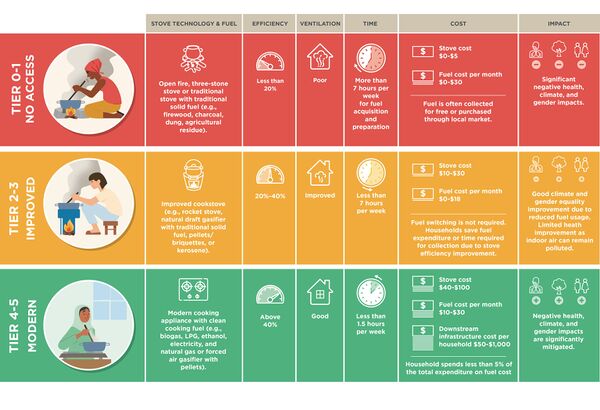
- ↑ ESMAP, n.d. Multi-Tier Framework for Measuring Energy Access. Available at: https://www.esmap.org/node/55526
- ↑ Yabei Zhang, World Bank on LinkedIn (July 2021): https://www.linkedin.com/feed/update/urn:li:activity:6825865579006623745/


